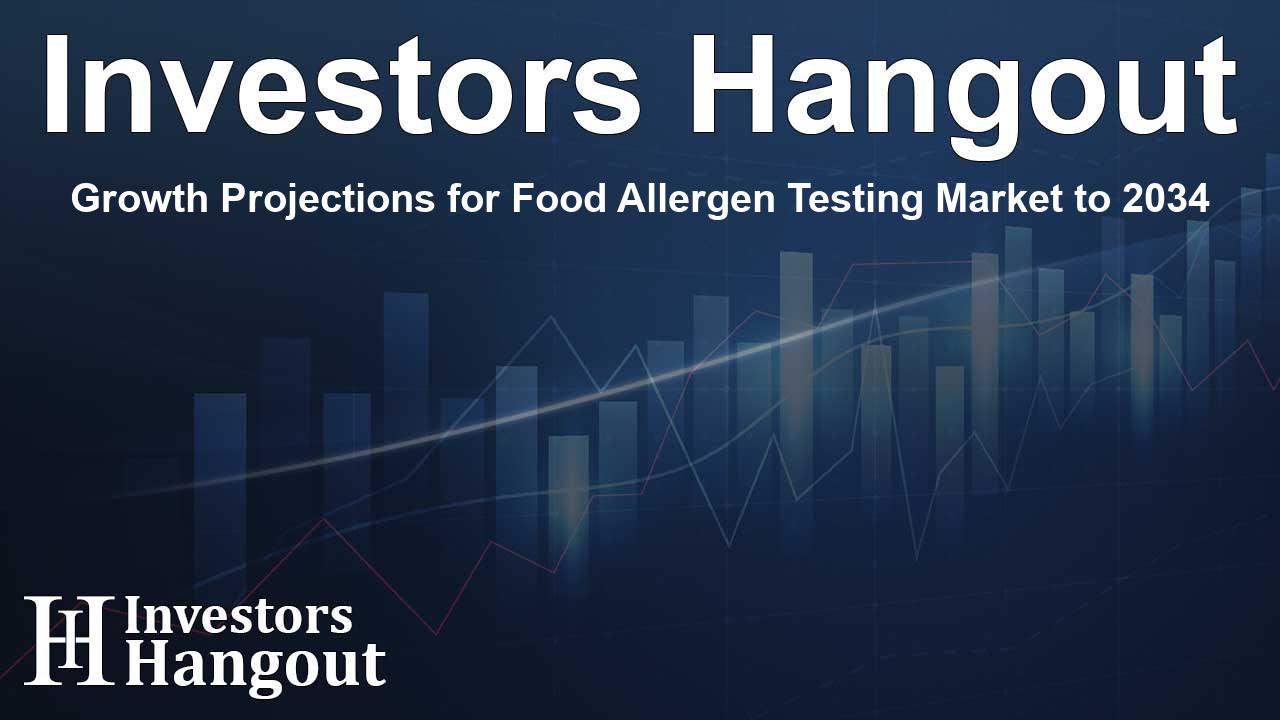Growth Projections for Food Allergen Testing Market to 2034

Overview of the Food Allergen Testing Market
The global food allergen testing market is anticipated to see remarkable growth in the coming years, with a projected compound annual growth rate (CAGR) of 7.8%. This growth is expected to propel market valuation from approximately $900 million to nearly $1.9 billion over a decade. The surging interest in allergen testing is largely a response to the growing concern about food allergies and their impact on public health.
The Shift to Rapid Testing Solutions
In today's fast-paced food production environment, allergy-testing strategies are evolving. Producers are increasingly turning to rapid detection technologies to ensure food safety. Traditional testing methods, while generally reliable, require extensive time in laboratory settings, which can delay critical decision-making.
Advantages of Rapid Testing Devices
Rapid testing solutions, such as biosensors and lateral flow devices (LFDs), are becoming more widely adopted. They enable quick, on-site testing with immediate results, fostering convenience and efficiency. These devices often employ a straightforward yes/no outcome, simplifying the process for workers on the production floor. Their use is primarily aimed at monitoring cleanliness, preventing cross-contamination, and verifying allergen-free conditions before packaging.
Market Dynamics and Consumer Concerns
The rising prevalence of food allergies, especially among children, is significant. Reports show that an estimated 8% of children and 4% of adults are affected by such allergies, underscoring the urgent demand for reliable testing methods to safeguard consumer well-being.
Consumer Preferences Drive Innovation
As consumers become more concerned about allergens, there is a distinct shift towards allergen-free products and clear labeling. This trend is catalyzing investments in advanced allergen-testing solutions, driving growth in the sector. Companies are increasingly tasked with demonstrating allergen-free claims on packaging, which has become a vital factor impacting consumer purchasing decisions.
Technological Advancements in Testing
New testing technologies, including rapid testing kits and multiplex assays, are enhancing detection capabilities, boosting both efficiency and accuracy. Furthermore, manufacturers are forming partnerships with testing laboratories to ensure routine allergen testing and compliance with safety standards while developing innovative allergen-free product lines to cater to health-conscious consumers.
Insights on Regional Growth
Market forecasts project significant consumption growth across countries with the largest markets for allergen testing. The fastest growth rates are expected from several key nations, suggesting a robust trajectory in demand coupled with cultural shifts regarding food safety. Countries like the USA, China, and Brazil are set to lead the market with expected CAGRs of 5.8%, 6.7%, and 8.1% respectively, as consumers become more vigilant about food safety and health.
Competitors and Market Players
The food allergen testing market is characterized by intense competition, driven by innovations and strategic partnerships. Leading entities in this space include Eurofins Scientific and SGS, working diligently to enhance their offerings through digital transformation and real-time monitoring systems.
Recent Developments
Eurofins Scientific's acquisition of Ajal Laboratories to expand testing services in Saudi Arabia highlights the ongoing consolidation in this sector. Additionally, health authorities focusing on food contamination incidents emphasize the critical need for rigorous allergen testing protocols across supply chains.
Future of Allergen Testing
The landscape of allergens testing is poised for continuous evolution. With advancements in testing technology, there is a possibility of achieving high sensitivity and specificity levels that rival traditional laboratory methods. As market dynamics shift and technology rises, the future for testing in the food industry looks bright, supporting both producers and consumers in ensuring food safety.
Frequently Asked Questions
What is the projected growth rate of the food allergen testing market?
The food allergen testing market is projected to grow at a CAGR of 7.8% from 2024 to 2034.
What are the main drivers for market growth?
The rising prevalence of food allergies and increasing consumer demand for allergen-free products and clear labeling are major drivers for market growth.
How do rapid testing technologies benefit food manufacturers?
Rapid testing technologies reduce waiting time for results, allowing for quicker decisions and minimizing allergen contamination risks during production.
What are some emerging technologies in allergen testing?
Emerging technologies in allergen testing include rapid testing kits and multiplex assays, which enhance detection efficiency and accuracy.
Who are the key players in the food allergen testing market?
Key players in the market include Eurofins Scientific, SGS S.A., Intertek Group plc, and Bureau Veritas, among others, competing through innovation and partnerships.
About Investors Hangout
Investors Hangout is a leading online stock forum for financial discussion and learning, offering a wide range of free tools and resources. It draws in traders of all levels, who exchange market knowledge, investigate trading tactics, and keep an eye on industry developments in real time. Featuring financial articles, stock message boards, quotes, charts, company profiles, and live news updates. Through cooperative learning and a wealth of informational resources, it helps users from novices creating their first portfolios to experts honing their techniques. Join Investors Hangout today: https://investorshangout.com/
Disclaimer: The content of this article is solely for general informational purposes only; it does not represent legal, financial, or investment advice. Investors Hangout does not offer financial advice; the author is not a licensed financial advisor. Consult a qualified advisor before making any financial or investment decisions based on this article. The author's interpretation of publicly available data shapes the opinions presented here; as a result, they should not be taken as advice to purchase, sell, or hold any securities mentioned or any other investments. The author does not guarantee the accuracy, completeness, or timeliness of any material, providing it "as is." Information and market conditions may change; past performance is not indicative of future outcomes. If any of the material offered here is inaccurate, please contact us for corrections.